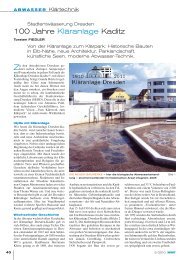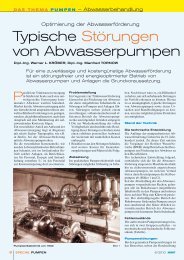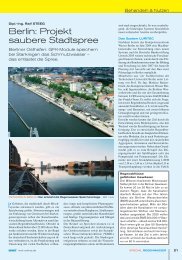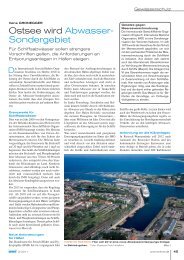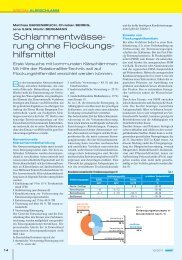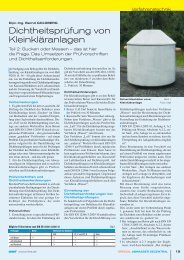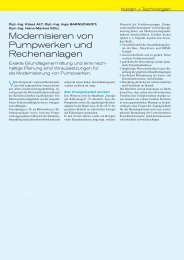international - wwt-online.de
international - wwt-online.de
international - wwt-online.de
You also want an ePaper? Increase the reach of your titles
YUMPU automatically turns print PDFs into web optimized ePapers that Google loves.
ENVIRONMENT Resource conservation<br />
MIKE 3: Mo<strong>de</strong>l tests on the Huangchengji bridge Image 15<br />
The limits of Chinese bureaucracy revealed<br />
themselves here. The vehicle was imported<br />
as air cargo for the above-mentioned handover.<br />
Following the handover, it took the<br />
Water Authority more than one year to officially<br />
import the vehicle through customs<br />
and have it licensed by the police. As is the<br />
case for all trucks (the vehicle was regar<strong>de</strong>d<br />
as a truck), the vehicle was licensed for traffic<br />
purposes but only for use at night! Even<br />
though the problem has now been solved,<br />
the vehicle is only used for special purposes.<br />
Integrated water resource<br />
management in the coastal region<br />
of the province of Shandong<br />
The river catchment of the Huangshuihe<br />
(1,034 km2), Image 11, in the north-east of<br />
the province of Shandong with its 64 km<br />
coastline offers a very good example of<br />
water conflicts which have arisen due to a<br />
rapidly growing population, industry and<br />
agriculture and uncoordinated water management<br />
measures, and which can only be<br />
solved by means of integrated water resources<br />
management (IWRM).<br />
Overuse of the water resources results in<br />
significant water management and agricultural<br />
problems due to salt water intrusion<br />
into the groundwater. The <strong>de</strong>velopment of<br />
industry and agriculture – the main source<br />
of income for the population – is severely<br />
restricted due to water shortage, and the<br />
contamination has consequences for ecology<br />
and the population’s quality of life. As<br />
part of the BMBF’s IWRM support programme,<br />
the joint project “Sustainable water<br />
resource management in the coastal area<br />
of the Shandong province PR China” was<br />
supported by the Chinese Ministry of Science<br />
and Technology (MOST) and the<br />
BMBF on the basis of a preliminary study<br />
(managed by Prof. W. Geiger, University of<br />
Essen). The project came to an end in December<br />
2010 and was coordinated by DHI-<br />
WASY GmbH. For more information, see<br />
http://www.bmbf.wasserressourcen-management.<strong>de</strong>/en/304.php.<br />
The goals are as follows:<br />
❙ integration of social, economic and environmental<br />
aspects<br />
Supported projects<br />
The following projects are/were supported<br />
by the German Fe<strong>de</strong>ral Ministry of<br />
Education and Research (BMFB):<br />
❙ Sino-German joint project “New concepts<br />
of rain water management in urban<br />
areas”; subproject 6: “GIS-based<br />
information system and analysis of<br />
ground water <strong>de</strong>velopment by quantity<br />
and quality”, ref. no.: 02WA 0051<br />
❙ Joint project: “Sustainable water concept<br />
and its use in the 2008 Olympic<br />
Games”; subproject G6: “Integrated<br />
monitoring and information management”;<br />
overall coordination of joint project,<br />
ref. nos.: 02WA0526 and 02WA<br />
1013<br />
❙ Joint project: “Sustainable water resource<br />
management in the coastal area<br />
of the Shandong province PR China”,<br />
subproject C: “Planning method and<br />
monitoring system for sustainable measures”;<br />
overall coordination of joint project,<br />
ref. no.: 02WM092<br />
❙ Joint project: “Guanting-Sustainable<br />
water and agricultural land use in the<br />
Guanting watershed un<strong>de</strong>r limited water<br />
resources”; subproject 2: “Water<br />
quantity management”; ref. no.: 02WM<br />
104 (see also http://www.bmbf.wasser<br />
ressourcen-management.<strong>de</strong>/en/606.<br />
php )<br />
❙ integrated analysis of groundwater and<br />
surface water (quantity and quality)<br />
❙ optimisation of the water supply for the<br />
entire watershed.<br />
The German project partners are Institute<br />
for Ecological Economy Research, Berlin,<br />
Institute of Hydrology, Water Resources<br />
Management and Environmental Engineering<br />
at Ruhr-University Bochum, Regierungsbaumeister<br />
Schlegel GmbH & Co.<br />
KG and Prof. W. Geiger.<br />
The Chinese project partners are the Water<br />
Management Authority of the province of<br />
Shandong, the Water Authority of Longkou,<br />
the Shandong Water Conservancy Research<br />
Institute, Jinan (Prof. Zhang Baoxian, Chinese<br />
project coordinator) as well as Shandong<br />
University and Shandong Normal<br />
University. Scientific coordination is the<br />
responsibility of Prof. W. Geiger, UNESCO<br />
Chair in Sustainable Water Management,<br />
Beijing / Munich.<br />
The project area has two special features: a<br />
reservoir casca<strong>de</strong> to enrich the ground water<br />
(Image 12) and a subterranean groundwater<br />
dam to prevent salt water intrusion from the<br />
sea.<br />
A DSS <strong>de</strong>signed to help optimise measures<br />
for sustainable water management is being<br />
<strong>de</strong>veloped as part of the project. The structure<br />
of the DSS is shown in Image 13.<br />
Particular attention is also being placed on<br />
improved monitoring in the project. In a<br />
previous rough analysis, weak spots were<br />
i<strong>de</strong>ntified in this regard. They mainly affected<br />
the recording of groundwater levels<br />
and water quality parameters – particularly<br />
of relevance for salt water intrusion into the<br />
groundwater body. Three new measuring<br />
stations have now been planned and constructed<br />
together with the Chinese partners<br />
in accordance with requirements (cf. Image<br />
6). The measuring stations are fitted with a<br />
solar-operated multi-parameter radioprobe,<br />
which continuously measures five parameter<br />
values (including conductivity) and transmits<br />
them daily to a website (<strong>de</strong>veloped by<br />
UGT GmbH). The Mobile Monitoring Shuttle<br />
was <strong>de</strong>veloped by UGT with Grundwasserforschungszentrum<br />
Dres<strong>de</strong>n e.V. for the<br />
purpose of mobile sampling, and ma<strong>de</strong><br />
available to the Chinese partner (MMS,<br />
<strong>de</strong>veloped by NAN UGT). The samples can<br />
thus be taken free of convection and with no<br />
pressure.<br />
A further weakness lies in the insufficient<br />
recording of flow quantities. Of particular<br />
concern is the lack of flow data for the<br />
largest tributary in the project area, the<br />
Huangchengji. In or<strong>de</strong>r to remedy the situation,<br />
a measurement system was <strong>de</strong>signed in<br />
consultation with the Chinese partners. This<br />
system is to be installed at the point just<br />
before the tributary flows into the main<br />
river. The high sediment rates, the irregular<br />
waterbed and the heavy fluctuations in flow<br />
46 INTERNATIONAL<br />
2011





